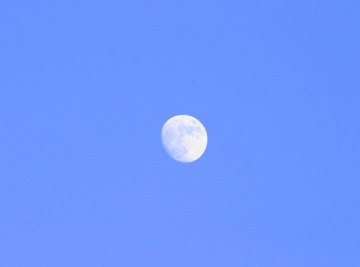
Eight distinct phases of the moon happen during a month’s period that can be examined with various projects. The first quarter, waxing crescent, new moon, waning crescent, third quarter, waning gibbous, full moon and waxing gibbous occur when the sunlight is reflected off the moon. Throughout the rotation, sunlight reflects off the moon to produce the phases.
Understanding the Phases of the Moon
The new moon cannot be seen because it is up during the day instead of at night. During the waxing crescent, a portion of the moon shows light, and the moon normally can be seen for a few moments after sunset. Waxing means a little more of the moon appears every night. In the first quarter phase, half the moon is lit up during the first half of the night. You can see the waxing gibbous phase of the moon most of the night. The full moon can be seen in its entirety once the evening hours begin. The waning gibbous stage occurs when you see less of the moon each night. In the last quarter, half the moon's surface is visible. The waning crescent can be seen best before dawn.
Recording Moon Phases
Watch the moon on a nightly basis and record what you have seen to understand how the moon is illuminated. Date your observations and record what time you went outside to look at the moon. When you see the moon, record what position it is in by using the horizon as your reference point. You can draw an arc to demonstrate where the moon’s path is across the sky. Your drawings should demonstrate what phase of the moon appears each night and help you determine what portion of the moon the sun is shining on.
Lunar Rotation and Revolution
This project will help people understand the movement of the moon. Have two people, one acting as the Earth and the other as the moon, face each other 5 feet apart. The moon moves counterclockwise around the Earth. After the first rotation of the moon is completed, add additional groups of two people. The additional pairs can demonstrate the phases of the moon.
Making Your Own Moon
Clean and dry a spherical object, such as a soccer or beach ball. Glue large squares of tinfoil to the ball, covering it completely. Place the ball on a sturdy surface once you complete it. Get a flashlight and turn off the lights. Shine the flashlight on one side of the moon, and walk to the other side, so you can see what is illuminated. The flashlight shows the different phases of the moon.
References
About the Author
Meghan McCoy began her journalism career in 2007, covering topics such as education, fitness entertainment and the arts. Her articles have appeared in "The Scottsdale Times," "The Apache Junction News," "The Cape Coral Daily Breeze" and "Charlotte Woman." McCoy received a Bachelor of Interdisciplinary Studies in mass Communication and sociology from Arizona State University.
Photo Credits
Photos.com/Photos.com/Getty Images
